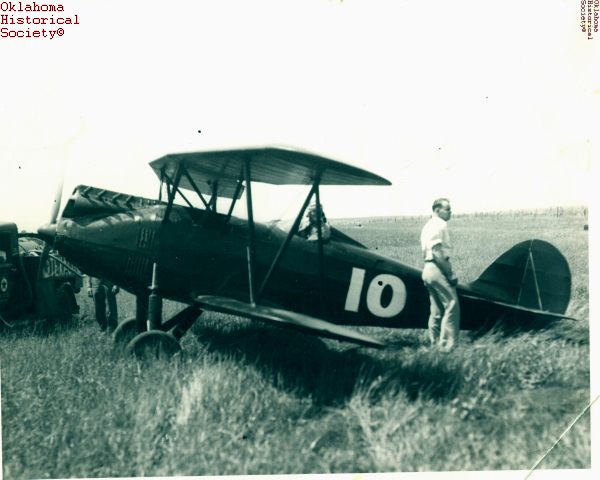| Aviator Roy Orlando
Hunt entered the world at Arapaho, Oklahoma, on May 29, 1897, born
to Walter Ernest and Elisa Burch Hunt. Roy Hunt attended public
schools and spent his youth in Carter, Oklahoma. Service in World
War I provided experience as an automobile mechanic, and by 1926 he
had settled in Norman, where he worked for B. S. Graham Flying
Service as an airplane mechanic. Hunt was one of a small,
enthusiastic, enterprising group that developed commercial aviation
in Oklahoma. A natural aptitude for flying led him to take up
aerobatics with James "Jimmy" Haizlip, Graham's chief pilot. In 1928
Hunt took over the Norman service when Haizlip moved to St. Louis,
where he won the Bendix Trophy in the 1932 National Air Races.
Competition also enthralled Hunt, and in 1931 he set a world's
record for the most consecutive outside loops, 124 in 124 minutes.
In 1932 he entered and won the Cord Cup Trans-Continental Air Derby,
one of the National Air Races, from Los Angeles to Cleveland. He
spent several years in California as an aviator for Curtiss-Wright
(which operated a large air field north of Oklahoma City), while
keeping his fleet of airplanes in Norman. In 1933 he moved his seven
ships from Norman to a new base at Oklahoma City Municipal Airport,
where he assumed management of Oklahoma Aviation Service, a freight,
passenger, and pilot training facility owned by Clint Johnson. In
1935 Oklahoma City oil man F. C. Hall, a flier and aviation
promoter, sponsored Hunt as a competitor for the Bendix Trophy in
the National Air Race, and he finished fourth.
source

Married twice, he wed the former Mrs. Bert Dodd, also a pilot, in
January 1944. She had graduated in October 1943 from the U.S. Army
ferry pilot school in Sweetwater, Texas. On February 4, 1944, while
flying to Virginia for a funeral, Hunt's plane crashed in Elkins,
West Virginia, killing himself and his new wife as well as Oklahoma
City First National Bank President Wilbur E. Hightower, Hightower's
daughter, and veteran pilot George Ruddy. With Hunt's untimely
death, Oklahoma lost a commercial aviation pioneer and a local
symbol of the new "air age."
|